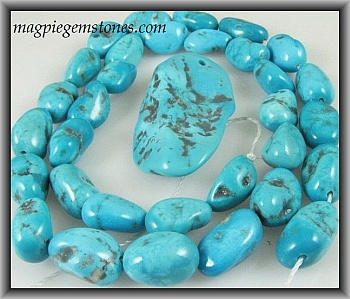Learn About Turquoise

Question from a client: On the topic of turquoise you seem to be quite knowledgeable, therefore I was wondering how can I know the difference between the various types of turquoise.
____________________________________________
Turquoise identification is something that I think has to be learned over time and exposure to the material. You really can't be taught how to identify turquoise by pictures or in words.
You can get a start there, though! My recommendation is only to buy turquoise from someone you trust and who also knows their turquoise and how to identify it. Buy it from the miners themselves if you can!
I can share some knowledge that may help navigate the turquoise waters. I will start with North American Turquoise.
American turquoise is the most expensive turquoise available and usually sells by the karat if it is high-grade material. If I see a strand of beads being sold as North American turquoise and the price is very low, I become very suspect of the true origin.
There is turquoise mined in China that is similar in color to some of the North American mines that some vendors attempt to pass off as turquoise from the US. Again someone who knows their turquoise can usually tell if it is Chinese or North American.
When a stone is made into a bead, there is a lot of loss shaping the bead, so normally, the better quality material is not made into beads but more often into cabochons and less often as nuggets. So if you see large blue 8 to 10mm natural Sleeping Beauty round beads for less than a thousand dollars there is one clue!
The medium to low-grade turquoise is stabilized and usually, color shot too. This is the turquoise they threw away back in the 1960's and early 70's. There is nothing wrong with stabilization as long as it is disclosed. It makes the lesser quality turquoise stronger so it can be used in jewelry, it makes turquoise beads less expensive so more people can afford them, and it keeps the turquoise from changing color as natural turquoise sometimes does when it touches the skin. Turquoise that is not gem grade (which only about 5% is) is more porous. The minerals from the oils in your skin will penetrate the turquoise over time and alter its color.
Only a very small percentage of all turquoise mined is considered gem grade material, that is is both hard enough to work and also holds its color. Medium to high grade is often natural but will change in color from skin oils. Medium to low-grade material can be used in jewelry if it is stabilized.
In the store, you can find natural North American and Chinese Turquoise.
The way turquoise is graded in the USA:
Zachery or Foutz process: Invented in the 1980's, this proprietary process that is virtually next to impossible to detect. It is the inclusion of quartz into the porous structure of turquoise. It is used on medium to higher grade turquoise to harden the turquoise and enhance the color. It also does not fade nor discolor where most natural untreated turquoise will discolor when worn.
Stabilized turquoise: Medium grade turquoise that has been stabilized, sometimes under pressure, to make the material hard enough to work into beads. Many turquoise cutters keep their stabilization process a closely held secret.
Stabilized and color shot: Medium to low-grade turquoise that is both stabilized and "color shot" to enhance the color. Color is added during the stabilization process to the material they use to stabilize.
Pressed: Low-grade turquoise that is crushed under pressure then stabilized and sometimes dyed. Some exotic combinations of turquoise with brass or copper in it are made using this or a similar method.
Reconstituted: The powder and small chips are swept up, mixed with resin and formed into beads.
Block: Material that has been stabilized, color shot and pressed into blocks to make into beads, this is often made from powdered material. Very low-quality turquoise is like chalk and crumbles apart. Most block now is not turquoise but only colored resin.
That is the basics of turquoise in a very general way.
For the past few years, there are all kinds of dyed blue, white, pink, orange, red, etc., stone coming out of China that is labeled as stabilized turquoise. Some of it has copper or black colored lines (fake matrix) on the surface of it, most of this product is dyed magnesite or something of that sort, not turquoise at all.
There was a big problem in Tucson at the gem and mineral show around this "stuff" a few years ago as many Chinese vendors were passing it off as turquoise. It was tested and now vendors are supposed to fully disclose their product.
Another thing they are doing from China is calling turquoise that has been clear stabilized "natural" turquoise. According to the standards in this country, it is not natural turquoise but clear stabilized. It is nice turquoise and affordable, yet it is not natural. They say it is natural because it is turquoise as opposed to the "other" turquoise many Chinese vendors sell which is usually magnesite dyed. It is how they choose to disclose their turquoise but it is not the same standards as in the United States.
If you Google turquoise mines, American turquoise, turquoise treatments, etc., you will come up with more info than you can imagine. The information is out there and this is just a very introductory article on the subject. I hope this helps a bit.
___________________________________________________________
Barbara emailed asking for more information on turquoise. "There is one area that continues to interest me........... Are the different colors of sky blue, green blue and very green just that...........various colors , some of which are preferred by individuals, or are there quality differences based on color?"
Ok, let's approach this one answer at a time.
Yes, the various colors are preferred by individuals and within this, there are quality preferences based on color. Turquoise is one of the gemstones that seems to attach itself emotionally to a person (or the other way around) so the individual preferences vary from all the blues to all the greens.
Some areas of the world do have regional preferences. The Southwestern United States seems to lean towards a popping blue with black matrix as turquoise that was very popular in the past was blue with black webbing, or matrix. There isn't that much of this turquoise around these days so black rouge or even black shoe polish is sometimes used to make the turquoise appear to have black webbing. Persians I do believe prefer the clearest of the blues, and China values the clear blue over others and grades their turquoise by color.
Also, within the same mining operation, sometimes within the same vein, both greens and blues will be found. The blue is the copper, and greens are molecules of zinc or iron. So value is not necessarily based on color even though blue does often sell for more because more people prefer it.
"Same query as it relates to matrix.......is the black veining preferred, or is the 'pure' or non-marred versions considered more valuable?"
I touched on this above with Southwestern preferences. Persians used to value clear over webbed, as well as China.
The most expensive turquoise I know of is Old Lander which sells for hundreds of dollars per karat. The rarity of Old Lander (less than 100 pounds mined) and its beauty make it a valuable collectible turquoise and has webbing or matrix, the pictures that I have seen of it does anyway. I have not held Old Lander in my hand.
"And lastly, is there ever a genuine white turquoise, or is it always some other 'massaged' gem? The other colors purported to be turquoise....red, orange, etc., are these genuine, or does turquoise always stay in the blue-green family?"
I have personally never seen white turquoise. I have seen something reputed to be white turquoise offered for sale a few years ago. I did research and the majority says no such thing yet there are a few folks out there who say there is.There is much debate in the turquoise world whether some specimens are turquoise or something else. A lab analysis of the questionable material would identify the stone properly.
As far as the pinks, purples, reds, mosaics, and oranges go, I know of no turquoise coming out of the earth in those colors. I do know of one North American processor that does stabilize and dye low-grade mine run in various colors. I also know these are more than a few bucks a strand too!
Almost everything I have seen is dyed magnesite and sometimes howlite.
There is a turquoise from China that is yellow/brown, it gets its color from the iron in the stone or another mineral depending on the color.
To sum this up, turquoise is emotional and every individual will have their personal tastes. I like all turquoise, from the eye-popping green of Orvil Jack to the whispey purple smoke of some Lavender Bisbee to electric blue or webbed from China, or sky blue from Persia.
To see a visual turquoise comparison chart click here.
To see Ky lighting turquoise on fire to see if it is stabilized click here.
Hope this helps a bit, Ky
~~All articles are copyright. You can reprint these articles as long as the original author is sited and a link to their site and this website is included. The name Magpie Gemstones must be used as the hypertext and link to the home page.~~








